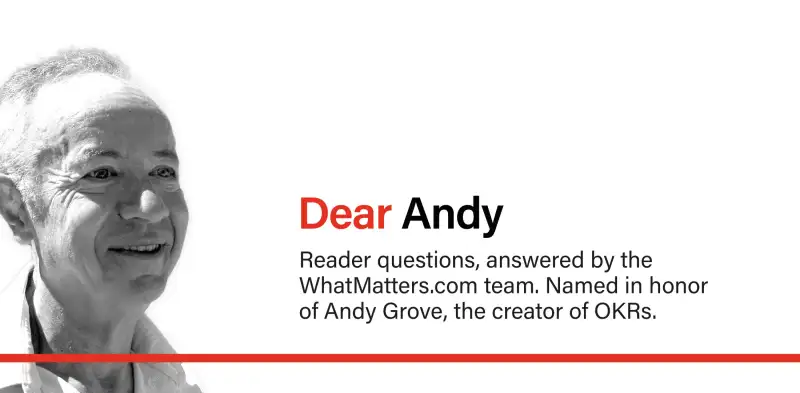Dear Andy,
I am working on my first-ever set of OKRs for my job in direct response marketing for annual giving for a university. I have collaborators and overlap with others at the university, but am essentially the sole proprietor of my function.
Here’s what I’m thinking about for my Objectives:
O1: Expand reach
O2: Make donors part of a community
O3: Giving is easy and emotionally satisfying
I worry that maybe these aren’t clear on their own — or is that okay if the KRs make them clear? “Expand reach,” for example, includes things like improving contactability, better matching platforms to the audience, improved open rates, etc. Also, to me, these Objectives feel somewhat eternal — these are the ongoing aims/challenges of my work. Should my Objectives really be something I am done with after a quarter or a year? Or can they stay somewhat constant with changing KRs?
Any insights are most welcome, and thank you in advance.
Veronica

Hi Veronica!
Thanks for writing in, and congrats on starting your OKR journey!
For your first time, you seem to have a very solid grasp on the fundamentals (much better than I did when I first started, I can tell you that much). Here are a few ideas to help you carry on the great work you’ve already started.
Your instinct that KRs help define the Objective is spot on. Without KRs, Objectives can sound too abstract to drive action. Let’s look at your second Objective: The idea of “community” is somewhat abstract on its own, but in combination with your KRs, you can define it in concrete and measurable ways. How will you know when your donors are a part of a community? What behaviors will improve or change that will tell you this has been achieved? The KRs are the milestones that tell you when your Objective has officially become — or is on the way to becoming — a reality.
As for your second question, it’s absolutely fine to keep an Objective for multiple cycles, but if your KRs are identical for more than a few, it’s probably time to dig deeper. Ideally, KRs adjust to reflect your needs at that time. For example, you may feel O1: Expand Reach is, to borrow a phrase, an “eternal” goal, but perhaps in one cycle you want to focus on new donors, and in another you want to focus on referrals from existing donors. One cycle may be all about communicating across multiple channels, and, in another, you’ll really want to focus on a new podcast for alumni or revenue-generating events.
In other words, the vision of expanding reach will remain the same, but the way you define an expanded reach will change. If there comes a day when you feel your reach is sufficiently expanded, or expanding reach simply isn’t beneficial to your overall cause anymore, you can mark that Objective as a win and shift your focus to a new goal.
And remember, even though they’re individual OKRs, you don’t necessarily have to go it completely alone. Run your OKRs by your collaborators. Even if they aren’t OKR users themselves (yet!), they may have valuable insight into what metrics signal strong community, or channels they think are best to reach out to. And who knows? Maybe they’ll be convinced to try out OKRs for themselves!
Appreciate you writing in, Veronica, and best of luck to you. Here’s hoping your first set of OKRs are a smashing success, and please keep us updated on your progress!
Sincerely,
Billy from the What Matters Team




